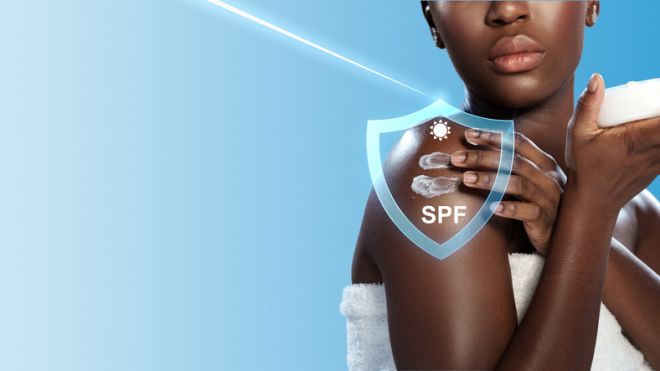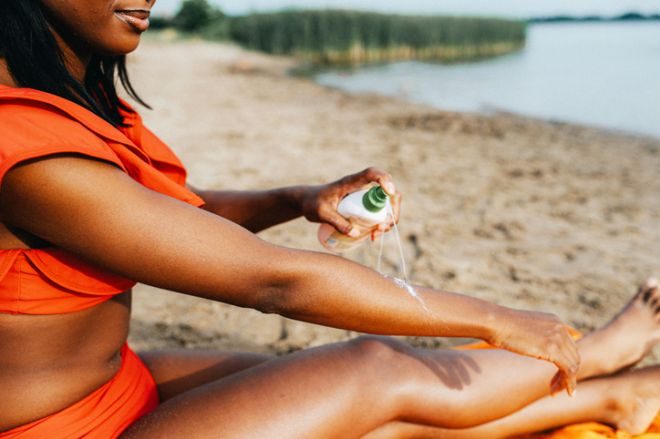Why Your Sunscreen May Not Be Working — Here's Why
Only 1 In 4 Sunscreens Are Safe—Here’s What Every Black Woman Should Know Before She Buys

Before you apply your sunscreen this summer, make sure you take a look at the content label to see if it’s really protecting you. The Environmental Working Group (EWG) has shed new light on sunscreen safety in the U.S., with its 19th Annual Guide to Sunscreens report. Released May 20, researchers from the consumer organization group uncovered that only 498 out of 2,204 sun protection products met their strict standards for safety and efficacy. This means less than a quarter of SPF products evaluated provide consumers with what the EWG considers reliable sun protection.
A good sunscreen should protect against the two main forms of ultraviolet rays (UV): UVB rays, which are the main cause of sunburn, and UVA rays, which contribute to skin cancer, wrinkling, and premature skin aging, Iowa Health Care notes.
“Our criteria include the ability of the sunscreen’s active ingredients to provide balanced protection against both UVA and UVB rays, as well as any hazardous chemical ingredients in the product,” David Andrews, acting chief science officer at the EWG, told CNN on May 27.
RELATED CONTENT: If Black Don’t Crack, Do We Really Need That Facial?
Sunscreens typically fall into two main categories: chemical and mineral. Chemical sunscreens absorb into the skin and rely on a chemical reaction to neutralize UV radiation. This reaction transforms UV rays into heat, which is then released from the body. But the chemical reaction, once absorbed into the skin, has harmful consequences on the body and the environment.
Beware of chemical-based sunscreens.

A 2019 study by the U.S. Food and Drug Administration (FDA) found that several commonly used sunscreen chemicals—avobenzone, oxybenzone, octocrylene, ecamsule, homosalate, octisalate, and octinoxate—can enter the bloodstream after just one day of use. The implications of this absorption are still being studied, but it raises significant concerns about long-term safety. One ingredient, in particular, oxybenzone, has drawn increasing scrutiny. Research has linked it to hormonal disruptions, including lower testosterone levels in adolescent boys, altered hormone levels in men, and complications in pregnancy such as shorter gestation periods and lower birth weights, CNN noted.
Furthermore, when people wear sunscreen at the beach or while swimming at a lake, residue from the substance can leach into the water and pose harm to living organisms and aquatic life. Out of caution, some countries have banned certain sunscreen ingredients in locations like Hawaii and the U.S. Virgin Islands, the National Academies notes.
Fortunately, the EWG’s 19th Annual Guide to Sunscreens report highlighted a dramatic decline in the use of oxybenzone. While it was once present in about 70% of non-mineral sunscreens, it now appears in just 9% of products. This change reflects growing awareness of its potential health risks, along with its negative impact on coral reefs and marine ecosystems.
Another ingredient falling out of favor is vitamin A (retinyl palmitate). Although once added to sunscreens for its supposed anti-aging benefits, studies suggest that it may break down in sunlight and increase the risk of skin damage. In 2010, vitamin A was found in 41% of sunscreens. By 2025, that number has plummeted to just 2%.
What are the best sunscreens?
The EWG’s findings suggest that while many sunscreens are still on the market, a relatively small number meet their benchmark for safety and effectiveness. The good news? Consumers are increasingly being offered better options, formulas that protect without questionable chemical exposures. Mineral-based sunscreens are a good place to start. This is because they sit on the skin’s surface and physically block or reflect UV rays using ingredients like zinc oxide or titanium dioxide, which are much safer for the body, aquatic life, and are generally recognized as safe and effective by the FDA.
“Of the 2,217 products we tested for this year’s report, 43% use zinc oxide or titanium dioxide, up from just 17% in 2007,” Andrews said. “That’s good news for consumers and the environment.”
However, be sure to read your sunscreen labels carefully. Some products contain hidden chemical “boosters” that may have long-term health consequences. According to Andrews, these boosters are used to artificially enhance the SPF level of a product. One example is butyloctyl salicylate (BOS), a solvent that not only makes sunscreens feel smoother and helps reduce the white cast often associated with mineral formulas but also absorbs UV radiation, functioning similarly to traditional chemical sunscreen ingredients. BOS in particular has been flagged in the past for needing more safety data, which means customers could be unknowingly exposed to UV-absorbing compounds that haven’t been thoroughly evaluated for long-term effects.
“Using chemical boosters may result in a lower concentration of active mineral ingredients at the expense[s] of consumer safety,” Andrews said. “We want to ensure these sunscreens are providing the SPF advertised on their labels as well as balanced UVA and UVB protection.”
If you’re looking for safe and effective sunscreens, several products from well-known brands like Supergoop, Sun Bum, and Banana Boat have received the stamp of approval from the EWG.
EWG-Approved Sunscreens Include:

Supergoop PLAY 100% Mineral Lotion, SPF 30
Supergoop Sunnyscreen Babies + Kiddos Sunscreen Lotion, SPF 50
Sun Bum Mineral Liquid Face Sunscreen Lotion, SPF 30
Banana Boat Sport Kids Sunscreen Stick, SPF 50+
Banana Boat Sport Sunscreen Stick, SPF 50+
You can read the full list of EWG-Approved Sunscreens here.
Protecting your skin against the sun is vital this summer. Wearing a powerful sunscreen can help to protect your skin against melanoma, hyperpigmentation, and potential scarring, so make sure you lather up well.
RELATED CONTENT: Summer Beauty Unlocked: 6 Hacks Every Black Girl Needs In Her Arsenal







